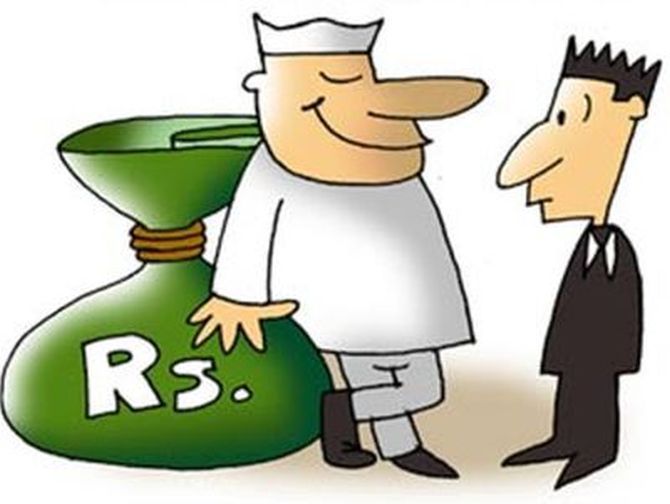'If the government has to reach the 18 per cent gross tax revenue growth target in the current year, the collections growth in the remaining eight months of 2019-20 must be 22 per cent.
'This is a huge target in a year of economic slowdown.
'If the tax revenue growth remains as tepid as 6.6 per cent, the revenue shortfall would be Rs 2.44 trillion or well over 1 per cent of GDP in the current year,' says A K Bhattacharya.
Illustration: Uttam Ghosh/Rediff.com

The Indian economy’s growth prospects look quite grim.
Its gross domestic product (GDP) grew by just 5 per cent in April-June 2019 in real terms, a six-year low.
This was even lower than the 5.8 per cent print recorded in the previous quarter.
A decelerating economy has obviously posed many challenges for the government.
One of these challenges pertains to the government’s tax revenue.
Even while the government formulates new packages to help the economy recover from such low levels of growth, it needs to worry about its own tax revenue as well.
How serious is the government’s tax revenue challenge?
First, let us disabuse ourselves of the estimates of very modest growth in revenue collections that the July Budget for 2019-20 had presented.
Those tax revenue growth numbers were arrived at by comparing the current year’s projected numbers over the revised estimates for 2018-19.
As we all know by now, the gap between the revised estimates and provisional accounts for 2018-19 was huge - the latter showed that the actual tax revenue was down by Rs 1.67 trillion compared to the revised estimates for the same year.
Thus, achieving the gross tax revenue target of Rs 24.61 trillion in 2019-20 will require the government to grow its tax revenue by over 18 per cent (when compared to the provisional accounts of 2018-19), almost double the 9 per cent growth the July Budget had shown.
The relatively low growth was because the July Budget had misleadingly used the revised estimates for 2018-19 to arrive at the revenue growth numbers for 2019-20.
A tax revenue growth target of 18 per cent is a tough task even when the economy does well on the growth front.
The last time the government's gross tax revenue grew by more than 18 per cent was in 2010-11.
That was nine years ago.
In the current year, the government had initially projected a nominal growth rate of 11 per cent for the Indian economy.
But the GDP’s nominal growth in the first quarter of 2019-20 was only 8 per cent, a 17-year low.
Achieving an 18 per cent gross tax revenue growth will call for a significant improvement in the tax buoyancy rate, which is unlikely.
Take a look at the tax revenue collections in the first four months of 2019-20.
Gross tax revenue collections in April-July 2019 have grown by just 6.6 per cent, almost a third of the desired rate of 18 per cent.
Collections of corporation tax, income-tax and central goods and services tax (CGST) have grown between 5.46 and 5.96 per cent.
Worse, central excise collections, which largely come from petrol and diesel, have seen a contraction of 10 per cent.
This is a puzzle. Consumption of petroleum products in this period has not declined, though it registered only a marginal increase of less than 2 per cent.
But in spite of that the excise collections should not have seen such a steep decline.
Central excise, even after the launch of the GST, accounts for about 12 per cent of the government’s gross tax collections.
Any decline of this nature should set alarm bells ringing in the government.
Interestingly, customs duty collections grew by over 20 per cent, beating the projected rate of 18 per cent.
But the share of customs duty in total gross tax collections is as low as about 6 per cent.
Therefore, any such increase in customs duty collections in the first four months is unlikely to help the government meet its tax revenue target at the end of the year.
If the government has to reach the 18 per cent gross tax revenue growth target in the current year, the collections growth in the remaining eight months of 2019-20 must be 22 per cent.
This is a huge target in a year of economic slowdown.
A bigger worry is the extent of the tax revenue shortfall the government may be staring at.
If the tax revenue growth remains as tepid as 6.6 per cent, the revenue shortfall would be Rs 2.44 trillion or well over 1 per cent of GDP in the current year.
If the government manages to end the year with a tax revenue growth rate of 10 per cent, which is unlikely given the current economic activity trends, the shortfall would not be much different at Rs 2.41 trillion.
Both the scenarios are quite worrying.
Also, the adverse impact of such a revenue shortfall on the states’ finances should not be underestimated.
The transfer of tax revenues to the states has seen lower growth this year.
At Rs 8.09 trillion, the transfer to the states will see an increase of only about 7 per cent, compared to a gross tax revenue growth rate of 18 per cent.
This is because the share of cess and surcharges in the new levies imposed in the current year has increased and since these are not shareable with the states, the net transfer to the states has grown at a lower rate.
But if the overall divisible tax pool itself shrinks, even a small increase of 7 per cent in transfer to states would become smaller.
For states, already struggling to meet their revenue targets and deficit goals, this will be another blow.
Of course, the government would be helped by the transfer of the excess contingency reserve of the Reserve Bank of India.
But that amount, an estimated Rs 58,000 crore, would reduce the revenue shortfall, but would not be able to wipe it out completely.
If the government cannot bring about any significant savings in its expenditure, then a significant slippage in the fiscal deficit target of 3.3 per cent of GDP looks very likely.












 © 2025
© 2025